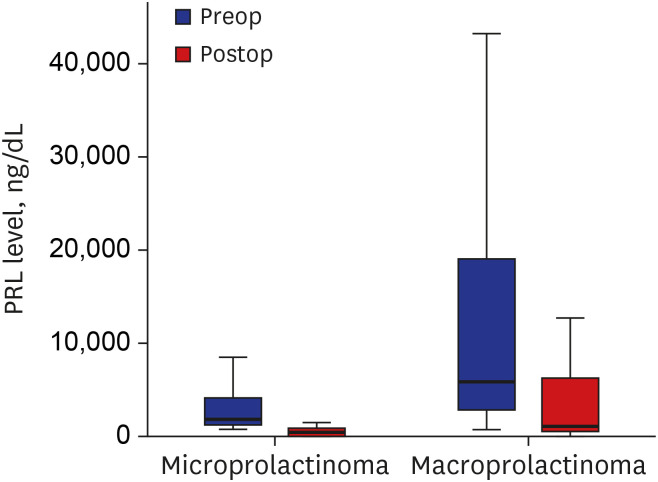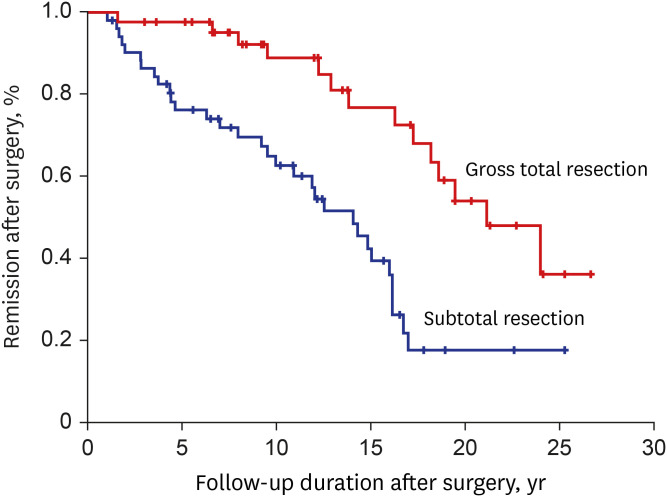J Korean Med Sci.
2021 Apr;36(15):e97. 10.3346/jkms.2021.36.e97.
Long-term Outcome of Microscopic Transsphenoidal Surgery for Prolactinomas as an Alternative to Dopamine Agonists
- Affiliations
-
- 1Department of Neurosurgery, Gachon University Gil Medical Center, Incheon, Korea
- 2Department of Neurosurgery, Chungnam National University Hospital, Daejeon, Korea
- 3Department of Neurosurgery, Soonchunhyang University Seoul Hospital, Seoul, Korea
- 4Department of Neurosurgery, Pusan National University Hospital, Busan, Korea
- 5Department of Neurosurgery, Seoul National University College of Medicine, Seoul, Korea
- 6Department of Otorhinolaryngology-Head and Neck Surgery, Seoul National University College of Medicine, Seoul, Korea
- 7Department of Internal Medicine, Seoul National University College of Medicine, Seoul, Korea
- KMID: 2515039
- DOI: http://doi.org/10.3346/jkms.2021.36.e97
Abstract
- Background
Although long-term dopamine agonist (DA) therapy is recommended as a first-line treatment for prolactinoma, some patients may prefer surgical treatment because of the potential adverse effects of long-term medication, or the desire to become pregnant. This study aimed to determine whether surgical treatment of prolactinomas could be an alternative to DA therapy.
Methods
In this retrospective study, 96 consecutive patients (74 female, 22 male) underwent primary pituitary surgery without long-term DA treatment for prolactinomas at a single institution from 1990 to 2010. All patients underwent primary surgical treatment in the microscopic transsphenoidal approach (TSA).
Results
The median age and median follow-up period were 31 (16–73) years and 139.1 (12.2–319.6) months, respectively. An initial overall remission was accomplished in 47.9% (46 of 96 patients, 33 macroadenomas, and 13 microadenomas) of patients. DA dose reduction was achieved in all patients after TSA. A better remission rate was independently predicted by lower diagnostic prolactin levels and by a greater extent of surgical resection. Overall remission at the last follow-up was 33.3%, and the overall recurrence rate was 30.4%. The permanent complication rate was 3.1%, and there was no mortality.
Conclusion
TSA can be considered a safe and potentially curative treatment for selective microprolactinomas as an alternative to treatment with a long-term DA.
Figure
Reference
-
1. Melmed S, Casanueva FF, Hoffman AR, Kleinberg DL, Montori VM, Schlechte JA, et al. Diagnosis and treatment of hyperprolactinemia: an Endocrine Society clinical practice guideline. J Clin Endocrinol Metab. 2011; 96(2):273–288. PMID: 21296991.
Article2. Casanueva FF, Molitch ME, Schlechte JA, Abs R, Bonert V, Bronstein MD, et al. Guidelines of the Pituitary Society for the diagnosis and management of prolactinomas. Clin Endocrinol (Oxf). 2006; 65(2):265–273. PMID: 16886971.
Article3. Gillam MP, Molitch ME, Lombardi G, Colao A. Advances in the treatment of prolactinomas. Endocr Rev. 2006; 27(5):485–534. PMID: 16705142.
Article4. Dekkers OM, Lagro J, Burman P, Jørgensen JO, Romijn JA, Pereira AM. Recurrence of hyperprolactinemia after withdrawal of dopamine agonists: systematic review and meta-analysis. J Clin Endocrinol Metab. 2010; 95(1):43–51. PMID: 19880787.
Article5. Molitch ME. Medical treatment of prolactinomas. Endocrinol Metab Clin North Am. 1999; 28(1):143–169. PMID: 10207689.
Article6. Zanettini R, Antonini A, Gatto G, Gentile R, Tesei S, Pezzoli G. Valvular heart disease and the use of dopamine agonists for Parkinson's disease. N Engl J Med. 2007; 356(1):39–46. PMID: 17202454.
Article7. Schade R, Andersohn F, Suissa S, Haverkamp W, Garbe E. Dopamine agonists and the risk of cardiac-valve regurgitation. N Engl J Med. 2007; 356(1):29–38. PMID: 17202453.
Article8. Biswas M, Smith J, Jadon D, McEwan P, Rees DA, Evans LM, et al. Long-term remission following withdrawal of dopamine agonist therapy in subjects with microprolactinomas. Clin Endocrinol (Oxf). 2005; 63(1):26–31. PMID: 15963057.
Article9. Cannavò S, Curtò L, Squadrito S, Almoto B, Vieni A, Trimarchi F. Cabergoline: a first-choice treatment in patients with previously untreated prolactin-secreting pituitary adenoma. J Endocrinol Invest. 1999; 22(5):354–359. PMID: 10401709.
Article10. Kharlip J, Salvatori R, Yenokyan G, Wand GS. Recurrence of hyperprolactinemia after withdrawal of long-term cabergoline therapy. J Clin Endocrinol Metab. 2009; 94(7):2428–2436. PMID: 19336508.
Article11. Amar AP, Couldwell WT, Chen JC, Weiss MH. Predictive value of serum prolactin levels measured immediately after transsphenoidal surgery. J Neurosurg. 2002; 97(2):307–314. PMID: 12186458.
Article12. Kreutzer J, Buslei R, Wallaschofski H, Hofmann B, Nimsky C, Fahlbusch R, et al. Operative treatment of prolactinomas: indications and results in a current consecutive series of 212 patients. Eur J Endocrinol. 2008; 158(1):11–18. PMID: 18166812.
Article13. Turner HE, Adams CB, Wass JA. Trans-sphenoidal surgery for microprolactinoma: an acceptable alternative to dopamine agonists? Eur J Endocrinol. 1999; 140(1):43–47. PMID: 10037250.
Article14. Buchfelder M, Schlaffer S. Surgical treatment of pituitary tumours. Best Pract Res Clin Endocrinol Metab. 2009; 23(5):677–692. PMID: 19945031.
Article15. Couldwell WT. Transsphenoidal and transcranial surgery for pituitary adenomas. J Neurooncol. 2004; 69(1-3):237–256. PMID: 15527094.
Article16. Qu X, Wang M, Wang G, Han T, Mou C, Han L, et al. Surgical outcomes and prognostic factors of transsphenoidal surgery for prolactinoma in men: a single-center experience with 87 consecutive cases. Eur J Endocrinol. 2011; 164(4):499–504. PMID: 21252173.
Article17. Jan M, Dufour H, Brue T, Jaquet P. Prolactinoma surgery. Ann Endocrinol (Paris). 2007; 68(2-3):118–119. PMID: 17512893.
Article18. Woodworth GF, Patel KS, Shin B, Burkhardt JK, Tsiouris AJ, McCoul ED, et al. Surgical outcomes using a medial-to-lateral endonasal endoscopic approach to pituitary adenomas invading the cavernous sinus. J Neurosurg. 2014; 120(5):1086–1094. PMID: 24527820.
Article19. Salazar-López-Ortiz CG, Hernández-Bueno JA, González-Bárcena D, López-Gamboa M, Ortiz-Plata A, Porias-Cuéllar HL, et al. Clinical practice guideline for the diagnosis and treatment of hyperprolactinemia. Ginecol Obstet Mex. 2014; 82(2):123–142. PMID: 24779268.20. Halperin Rabinovich I, Cámara Gómez R, García Mouriz M, Ollero García-Agulló D. Grupo de Trabajo de Neuroendocrinología de la SEEN. Clinical guidelines for diagnosis and treatment of prolactinoma and hyperprolactinemia. Endocrinol Nutr. 2013; 60(6):308–319. PMID: 23477758.
Article21. Ma Q, Su J, Li Y, Wang J, Long W, Luo M, et al. The chance of permanent cure for micro- and macroprolactinomas, medication or surgery? a systematic review and meta-analysis. Front Endocrinol (Lausanne). 2018; 9:636. PMID: 30410470.
Article22. Donegan D, Atkinson JL, Jentoft M, Natt N, Nippoldt TB, Erickson B, et al. Surgical outcomes of prolactinomas in recent era: results of a heterogenous group. Endocr Pract. 2017; 23(1):37–45. PMID: 27682355.
Article23. Primeau V, Raftopoulos C, Maiter D. Outcomes of transsphenoidal surgery in prolactinomas: improvement of hormonal control in dopamine agonist-resistant patients. Eur J Endocrinol. 2012; 166(5):779–786. PMID: 22301915.
Article24. Klibanski A. Dopamine agonist therapy in prolactinomas: when can treatment be discontinued? J Clin Endocrinol Metab. 2009; 94(7):2247–2249. PMID: 19584197.
Article25. Dallapiazza RF, Jane JA Jr. Outcomes of endoscopic transsphenoidal pituitary surgery. Endocrinol Metab Clin North Am. 2015; 44(1):105–115. PMID: 25732647.
Article26. Dehdashti AR, Ganna A, Karabatsou K, Gentili F. Pure endoscopic endonasal approach for pituitary adenomas: early surgical results in 200 patients and comparison with previous microsurgical series. Neurosurgery. 2008; 62(5):1006–1015. PMID: 18580798.27. Cappabianca P, Cavallo LM, Colao A, de Divitiis E. Surgical complications associated with the endoscopic endonasal transsphenoidal approach for pituitary adenomas. J Neurosurg. 2002; 97(2):293–298. PMID: 12186456.
Article28. Pascal-Vigneron V, Weryha G, Bosc M, Leclere J. Hyperprolactinemic amenorrhea:treatment with cabergoline versus bromocriptine. Results of a national multicenter randomized double-blind study. Presse Med. 1995; 24(16):753–757. PMID: 7784413.29. Maiter D. Management of dopamine agonist-resistant prolactinoma. Neuroendocrinology. 2019; 109(1):42–50. PMID: 30481756.
Article30. Vroonen L, Jaffrain-Rea ML, Petrossians P, Tamagno G, Chanson P, Vilar L, et al. Prolactinomas resistant to standard doses of cabergoline: a multicenter study of 92 patients. Eur J Endocrinol. 2012; 167(5):651–662. PMID: 22918301.
Article31. Jethwa PR, Patel TD, Hajart AF, Eloy JA, Couldwell WT, Liu JK. Cost-effectiveness analysis of microscopic and endoscopic transsphenoidal surgery versus medical therapy in the management of microprolactinoma in the United States. World Neurosurg. 2016; 87:65–76. PMID: 26548828.32. Zygourakis CC, Imber BS, Chen R, Han SJ, Blevins L, Molinaro A, et al. Cost-effectiveness analysis of surgical versus medical treatment of prolactinomas. J Neurol Surg B Skull Base. 2017; 78(2):125–131. PMID: 28321375.33. Duan L, Yan H, Huang M, Zhang Y, Gu F. An economic analysis of bromocriptine versus trans-sphenoidal surgery for the treatment of prolactinoma. J Craniofac Surg. 2017; 28(4):1046–1051. PMID: 28145933.
Article34. Song YJ, Chen MT, Lian W, Xing B, Yao Y, Feng M, et al. Surgical treatment for male prolactinoma: a retrospective study of 184 cases. Medicine (Baltimore). 2017; 96(2):e5833. PMID: 28079813.
- Full Text Links
- Actions
-
Cited
- CITED
-
- Close
- Share
- Similar articles
-
- Update in Prolactinomas
- A Case of Bromocriptine Resistant Hyperprolactinemia Which was Responsive to Pergolide
- Dopamine agonists in the treatment of hyperprolactinemia cycle and fertility disorders: comparison between lisuride and bromocriptine
- Surgical Treatment of Prolactinomas: Potential Role as a First-Line Treatment Modality
- Updates on the Treatment of Restless Legs Syndrome



